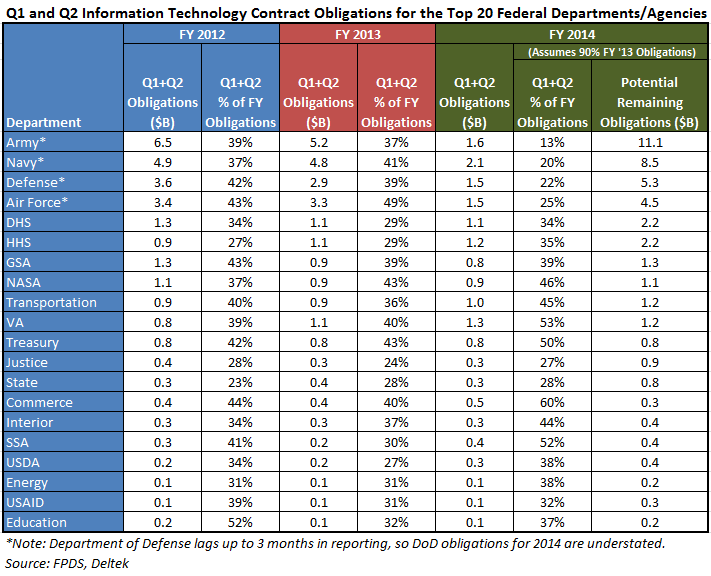IT Contracting Half-way Through FY 2014 – Civilian is Chugging, but Can DoD Catch Up?
Published: April 15, 2014
USAIDUSDAUSAFARMYBudgetDOCDEFENSEEDUCDOEForecasts and SpendingGSAHHSDHSDOIDOJDOLNASANAVYSSASTATEDOTTREASVA
Last week, I looked at the total market contract obligations at the mid-fiscal-year point. This week I’ll look specifically at IT obligations. In this, and other similar scenarios that I have explored, I took a rough “back of envelope” approach to projecting potential contract obligation rates for the remaining two fiscal quarters. For consistency, I will use the same baseline: If agencies obligate at least 90% of what they did in FY 2013, what might that project for spending on contracts in the second half of this fiscal year.
In the latest federal FY 2015 IT budget request, OMB reported the total enacted FY 2014 IT budget to be about $75 billion, which is $2.5 billion (3.5%) more than agencies spent in FY 2013. So this 90% threshold that I am using for potential FY 2014 spending, while not a perfect comparison, might be conservative. We’ll just have to see.
Contract Obligations Compared
For IT, these twenty top-spending departments account for $16.2 billion in combined Q1 and Q2 obligations for FY 2014 so far, although DoD’s reporting lag will most certainly increase that amount. If they spend 90% of what they did in FY 2013 they will have $43.2 billion left to obligate in the remaining two quarters of this fiscal year. (See table below.) Under that assumption, the remaining federal departments and agencies would account for roughly $1.1 billion for Q3 and Q4, reaching the overall $44.4 billion mark for the second half of the year.

Observations
- The civilian agencies in the top twenty have reported yearly obligations of $9.4 billion, $8.9 billion, and $9.5 billion for FY 2012, 2013 and 2014 respectively. So for FY 2014 these civilian departments are currently running on par with FY 2012.
- The defense branches have reported yearly obligations of $18.4 billion, $16.2 billion and $6.7 billion for FY 2012, 2013, and 2014 respectively. Granted, the FY 2014 Q1-Q2 data is incomplete due to DoD’s reporting lag, which could take up to 90 days to settle out. So the question then is whether we will see another $10 billion in obligations post to the defense branches in the coming days to put them on par with last fiscal year or whether we will see the softening that’s apparent from FY 2012 to FY 2013.
- Outside of DoD, there is not that much variance year-over-year. Most departments are within $100 million of what they spend in Q1-Q2 of last year. The SSA, USDA, and VA have posted increases of $200 million in obligations over this time in FY 2013.
What we may be seeing in the data so far – at least with the civilian organizations – is that they are enjoying the benefits of having budgets in place relatively early in the fiscal year, compared to dealing with CRs and late-breaking omnibus spending measures. There’s no surprise there. The real story in the data may be what is happening in the defense sector – that draw-downs, realignments, and program delays appear to be having noticeable impacts on their IT contracting run rates. Only time will tell if they will make up the difference in the second half of the year.